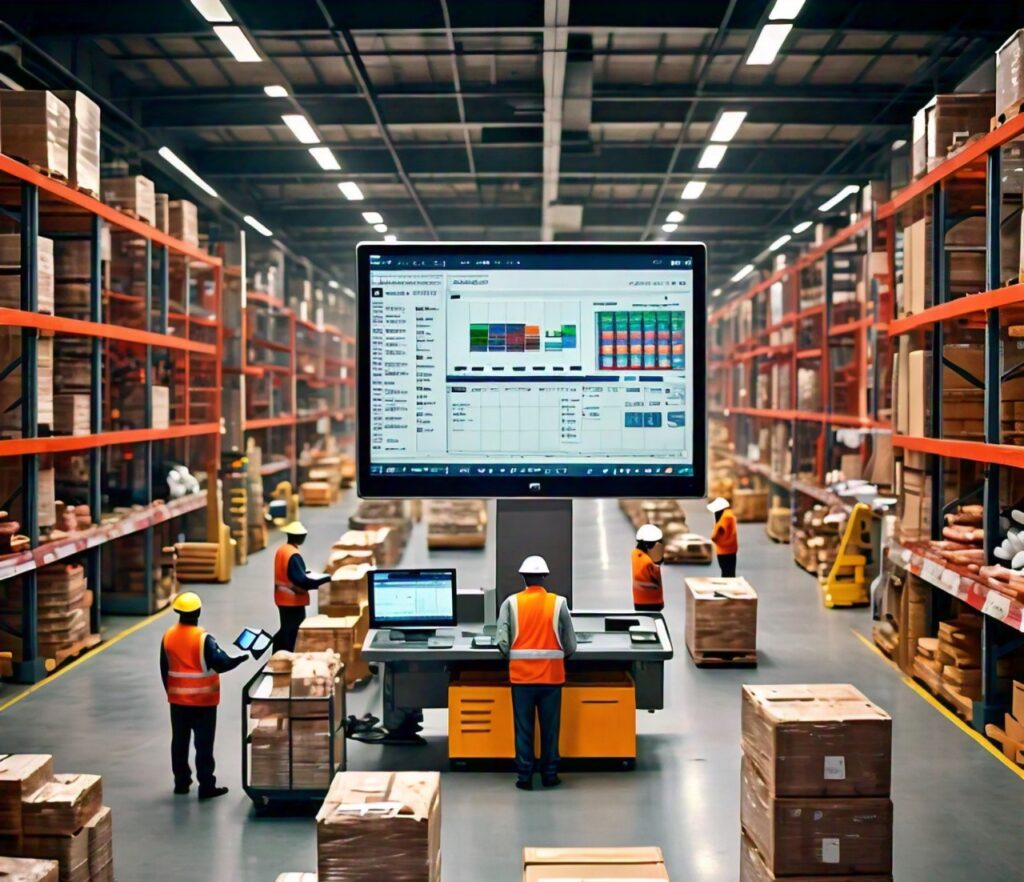Blockchain technology is rapidly transforming the landscape of global trade. By providing a secure, transparent, and decentralized platform for recording and verifying transactions, blockchain is revolutionizing how goods and services are exchanged across borders. This technology addresses critical challenges in international trade, such as fraud, inefficiencies, and lack of transparency, while also paving the way for more streamlined and trustworthy global commerce
In recent years, blockchain technology has emerged as a transformative force across various industries. At its core, blockchain is a decentralized digital ledger that securely records transactions across a network of computers. Each transaction, or “block,” is linked to the previous one, creating a continuous “chain” of information. This technology is characterized by its transparency, immutability, and distributed nature, which ensures that data is accurate and tamper-proof.
Importance of Securing International Trade
International trade is the lifeblood of the global economy, facilitating the exchange of goods and services across borders. However, this intricate web of transactions is not without its challenges. Issues such as fraud, counterfeiting, and inefficiencies in documentation and compliance can pose significant risks. Ensuring the security and efficiency of these transactions is crucial for maintaining trust and optimizing the global supply chain.
This article aims to explore how blockchain technology is being applied to enhance security and efficiency in international trade. By delving into the practical applications of blockchain, we will illustrate how this technology addresses key challenges in global transactions. Through a detailed examination of its benefits, real-world examples, and potential future developments, this article will provide a comprehensive understanding of blockchain’s role in securing international trade.
The Basics of Blockchain Technology
What is Blockchain?
Blockchain technology is a decentralized system that securely records transactions across multiple computers. Each transaction is grouped into a “block,” which is then linked to the previous block, forming a “chain.” This structure creates a continuous, tamper-evident record of all transactions.
Core Components:
- Blocks: Each block contains a list of transactions and is identified by a unique hash. Once a block is added to the chain, its contents cannot be altered without changing all subsequent blocks.
- Chain: The chain is a series of blocks linked together in chronological order. Each block references the previous block’s hash, creating a secure and immutable record.
- Nodes: Nodes are individual computers in the network that store a copy of the blockchain. They work together to validate and record new transactions.
How Blockchain Operates:
- Consensus Mechanisms: Blockchain networks use consensus algorithms, such as Proof of Work (PoW) or Proof of Stake (PoS), to agree on the validity of transactions. These mechanisms ensure that all participants in the network agree on the state of the blockchain.
- Validation: When a transaction is proposed, it is broadcasted to the network. Nodes validate the transaction according to predefined rules. Once validated, the transaction is added to a new block and appended to the chain.
Key Blockchain Concepts Relevant to Trade
Smart Contracts: Smart contracts are self-executing contracts with the terms of the agreement directly written into code. These contracts automatically enforce and execute the terms when predefined conditions are met, reducing the need for intermediaries and minimizing the risk of disputes.
Distributed Ledger Technology (DLT): DLT refers to the technology that distributes data across multiple nodes, ensuring that no single entity has control over the entire ledger. Blockchain is a type of DLT that uses a chain of blocks to record transactions. DLT provides transparency and security by making the ledger accessible to all participants while preventing tampering.
Cryptographic Hashing: Cryptographic hashing involves generating a fixed-size output (hash) from input data. In blockchain, hashes are used to link blocks together securely. Each block’s hash includes the hash of the previous block, ensuring that any attempt to alter the data in one block would require changing all subsequent blocks, which is computationally infeasible.
Also Read: Trade Wars: The Future and What Lies Ahead

Applications of Blockchain in International Trade
Secure Documentation and Authentication
One of the key challenges in international trade is ensuring the authenticity and security of documentation. Blockchain technology offers a robust solution by digitizing and securing trade documents.
Digitizing Trade Documents: Traditionally, international trade relies heavily on paper documentation, which is prone to loss, forgery, and delays. Blockchain enables the creation of digital versions of essential documents such as bills of lading, certificates of origin, and customs declarations. These digital documents are stored on a blockchain, providing a secure and tamper-proof record.
Reducing Fraud and Counterfeiting: Blockchain’s immutable nature ensures that once a document is recorded on the blockchain, it cannot be altered or forged. This helps in reducing the risk of fraud and counterfeiting. For example, a certificate of origin recorded on the blockchain can be verified by all parties involved, ensuring its authenticity and preventing the circulation of counterfeit documents.
Streamlining Trade Finance
Trade finance is crucial for facilitating transactions between buyers and sellers across borders. Blockchain technology can significantly streamline this process by automating and securing trade finance transactions.
Facilitating Letters of Credit: Letters of credit (LCs) are commonly used in international trade to guarantee payment. Blockchain can automate the issuance, verification, and execution of LCs through smart contracts. Once the terms of the LC are met, the smart contract automatically triggers payment, reducing the need for intermediaries and expediting the transaction process.
Enhancing Supply Chain Transparency
Supply chain transparency is critical for tracking the provenance and status of goods throughout their journey from manufacturer to consumer. Blockchain provides a solution by enabling real-time tracking and verification.
Tracking and Verifying Goods: Blockchain allows all participants in the supply chain to access a shared, immutable record of goods as they move through different stages. This transparency helps in verifying the origin and authenticity of products, such as ensuring that food products are sourced from approved suppliers or that luxury items are genuine.
Improving Visibility and Accountability: With blockchain, stakeholders can track each transaction and movement of goods in real-time. This increased visibility helps in identifying and addressing issues quickly, such as delays or discrepancies, and holds all parties accountable for their role in the supply chain.
Also Read: Transfer Payments Explained: Key Insights

Automating Compliance and Regulation
Compliance with international trade regulations can be complex and time-consuming. Blockchain technology can simplify and automate compliance processes.
Automated Customs and Tariff Management: Blockchain can automate customs procedures and tariff calculations by recording and verifying compliance with trade regulations. Smart contracts can ensure that all regulatory requirements are met before goods are cleared for shipment, reducing paperwork and administrative burdens.
Benefits of Blockchain for International Trade
Increased Security
Blockchain technology offers several benefits that enhance the security of international trade transactions.
Reducing the Risk of Data Tampering and Fraud: Blockchain’s immutability ensures that once a transaction is recorded, it cannot be altered or deleted. This feature significantly reduces the risk of data tampering and fraud. For example, altering a trade document or falsifying transaction records would require changing all subsequent blocks in the chain, which is computationally infeasible. As a result, stakeholders can trust the integrity of the data recorded on the blockchain.
The Role of Cryptography in Securing Transactions: Cryptographic techniques are fundamental to blockchain’s security. Each transaction is secured by a cryptographic hash, and the use of public and private keys ensures that only authorized parties can access or modify the data. This cryptographic layer provides robust protection against unauthorized access and ensures that transactions are both secure and verifiable.
Improved Efficiency
Blockchain can significantly improve the efficiency of international trade by reducing the time and cost associated with traditional processes.
Reducing Paperwork and Manual Processing: The automation of documentation and transaction verification through blockchain reduces the need for manual processing and paperwork. Smart contracts, for instance, automatically execute and enforce the terms of agreements, eliminating the need for intermediaries and reducing administrative overhead. This streamlining of processes results in faster and more efficient transactions.
Accelerating Transaction Times and Reducing Costs: Blockchain’s real-time processing capabilities enable quicker transactions compared to traditional methods. By eliminating intermediaries and automating processes, blockchain reduces transaction costs and accelerates settlement times. For example, a cross-border payment that traditionally takes several days can be completed within minutes using blockchain technology.
Enhanced Transparency and Traceability
Blockchain’s transparency and traceability features offer significant advantages for international trade.
Real-Time Tracking and Auditing Capabilities: Blockchain provides a transparent, real-time view of the entire transaction history. Each transaction is recorded on a public ledger that all participants can access, offering full visibility into the movement of goods and funds. This transparency facilitates real-time tracking and auditing, allowing stakeholders to monitor transactions and verify their authenticity.
Building Trust Among Trade Partners: The transparency provided by blockchain helps build trust among trade partners by ensuring that all parties have access to the same information. This shared visibility reduces disputes and enhances collaboration, as each party can verify the accuracy and integrity of the data. Trust is crucial in international trade, where relationships are often built on the reliability of documentation and transactions.
Further Read: Why Emerging Markets Are the Next Frontier in International Trade
Challenges and Limitations
Scalability Issues
While blockchain technology offers numerous benefits, it also faces challenges related to scalability, particularly when applied to international trade.
Technical Challenges Related to Scaling Blockchain Networks: Scalability is a significant concern for blockchain networks, especially when handling a high volume of transactions. Traditional blockchain architectures, such as those using Proof of Work (PoW), can experience delays and increased transaction costs as the network grows. These issues arise because each transaction requires validation by multiple nodes, which can lead to bottlenecks and slower processing times.
Potential Solutions and Approaches: Several approaches are being explored to address scalability challenges. One such solution is the implementation of Layer 2 protocols, like the Lightning Network, which operates on top of the main blockchain to facilitate faster transactions. Another approach is the use of alternative consensus mechanisms, such as Proof of Stake (PoS), which can handle a higher volume of transactions with greater efficiency. Additionally, advancements in blockchain technology, such as sharding, aim to improve scalability by dividing the network into smaller, manageable parts.
Integration with Existing Systems
Integrating blockchain technology with existing trade systems presents its own set of challenges.
Challenges in Integrating Blockchain with Legacy Trade Systems: Many international trade processes rely on legacy systems that may not be compatible with blockchain technology. Integrating blockchain with these existing systems requires significant adjustments and adaptations. This integration can involve technical challenges, such as ensuring data compatibility and synchronizing blockchain records with traditional databases.
Potential Solutions and Approaches: To overcome integration challenges, businesses can adopt a phased approach, starting with pilot projects to test blockchain applications in specific areas of trade. Additionally, collaboration between blockchain developers and industry stakeholders is crucial for developing standards and interoperability solutions. By addressing these integration issues, organizations can gradually incorporate blockchain into their existing systems and workflows.
Regulatory and Legal Considerations
Blockchain’s implementation in international trade also raises regulatory and legal questions.
Current Regulatory Landscape for Blockchain in Trade: The regulatory environment for blockchain technology varies by region and is still evolving. Different countries have different approaches to regulating blockchain applications in trade, which can create uncertainty and complexity for businesses operating internationally. Compliance with diverse regulations and standards is essential for successful blockchain adoption.
Addressing Legal and Compliance Issues: Organizations must navigate legal and regulatory requirements when implementing blockchain solutions. This includes ensuring compliance with data protection laws, intellectual property rights, and trade regulations. Collaborating with legal experts and regulatory bodies can help businesses understand and address these issues, ensuring that blockchain implementations are compliant with applicable laws.
Emerging Innovations in Blockchain for Trade
As blockchain technology continues to evolve, several emerging innovations hold promise for further transforming international trade.
New Technologies and Enhancements on the Horizon:
- Blockchain Interoperability: Future developments are focused on improving interoperability between different blockchain networks. This will enable seamless data exchange and transactions across various blockchain platforms, enhancing the efficiency of international trade operations.
- Advanced Smart Contracts: Innovations in smart contract technology are expected to introduce more sophisticated automation and customization. These advancements will allow for more complex agreements and automated processes, reducing the need for human intervention and minimizing errors.
- Scalable Blockchain Solutions: New consensus mechanisms and Layer 2 scaling solutions are being developed to address current scalability issues. These technologies aim to increase transaction throughput and reduce costs, making blockchain more practical for high-volume trade applications.
Potential Impact of Advancements on International Trade: These innovations are likely to further streamline trade processes, enhance security, and improve transparency. For example, increased blockchain interoperability could facilitate global trade by enabling seamless cross-border transactions and data sharing. Enhanced smart contracts may automate and optimize complex trade agreements, while scalable solutions will support larger and more efficient trade networks.
Also Read: The Impact of Trade Deficits on National Economies

Blockchain and Other Emerging Technologies
The integration of blockchain with other emerging technologies is expected to drive further advancements in international trade.
Integration with IoT (Internet of Things): Blockchain and IoT can work together to enhance supply chain visibility and automation. IoT devices can collect real-time data on the movement and condition of goods, which is then recorded on a blockchain. This integration provides a transparent and verifiable record of each step in the supply chain, improving traceability and reducing the risk of fraud.
Integration with AI (Artificial Intelligence): AI and blockchain can complement each other by combining AI’s data analysis capabilities with blockchain’s secure and transparent record-keeping. AI can analyze blockchain data to identify patterns, predict trends, and optimize trade processes. For instance, AI-powered algorithms can enhance risk management and decision-making in trade finance by analyzing historical data stored on a blockchain.
You can also Read: Bitcoin’s Surge Analysis: Trends, Indicators & Impact
Conclusion
Blockchain technology has the potential to revolutionize international trade by enhancing security, improving efficiency, and increasing transparency. Through its decentralized, immutable ledger and advanced features such as smart contracts and distributed ledger technology (DLT), blockchain addresses many of the challenges faced in global trade, including documentation fraud, inefficiencies in trade finance, and lack of supply chain visibility.
Key Benefits Recap:
- Increased Security: Blockchain reduces the risk of data tampering and fraud through its immutable record and cryptographic techniques.
- Improved Efficiency: Automation and real-time processing capabilities streamline trade processes, reducing paperwork and transaction costs.
- Enhanced Transparency: Real-time tracking and auditing capabilities build trust among trade partners and provide a transparent view of transactions.






